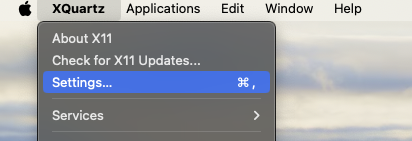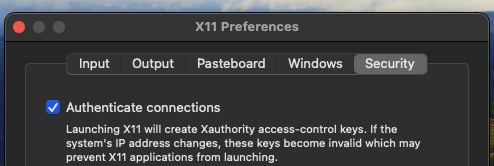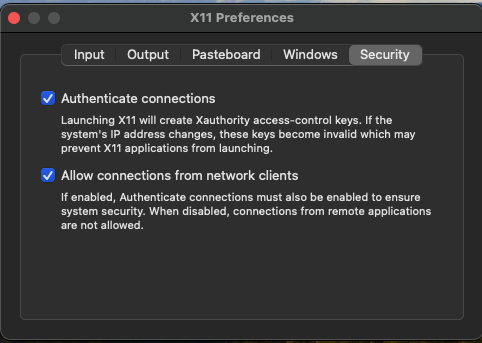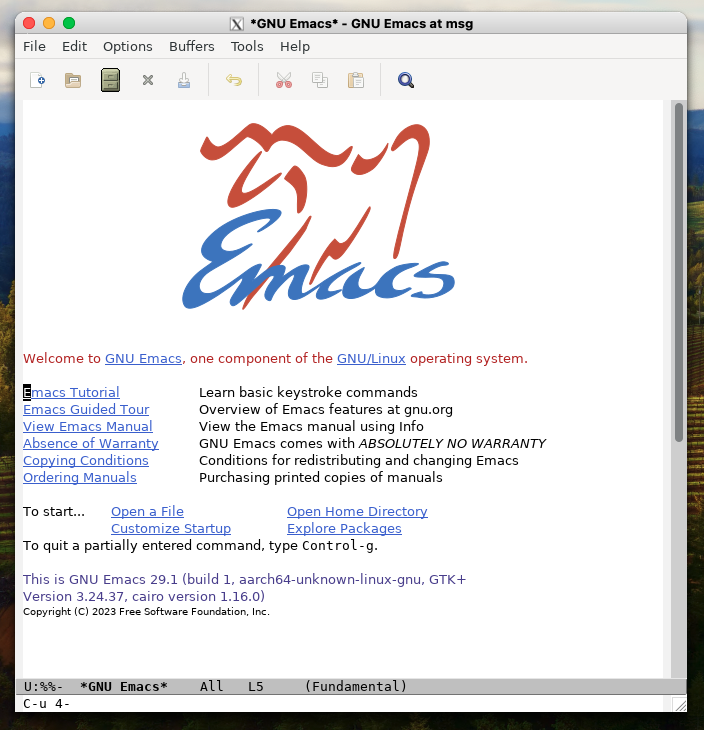Running Graphical Applications With MSG
Table of Contents
| HOME | PROJECTS | BLOG | ABOUT |
| MSG | Articles | Contact | |
| PACKAGES | Reviews |
Intro
While MSG comes out of the box with mainly cli tooling, you are also able to forward graphical X11 applications from MSG to the MacOS host running Xquartz.
Setup Environment
Install MSG
Install Xquartz
Configure Xquartz
- Open Xquartz and use the Menu Bar to access the settings

- Select the Security tab

- Enable "Allow connections from network clients"

- Reboot your Mac
Update MSG Environment
- Run the MSG Guix application
- Enter the MSG shell using
guix shell - Run
guix pullfollowed bysudo guix system reconfigure /etc/config.scm - Reboot with
sudo reboot
Install App to Run
Try Running without Desktop dependencies
The simplest way to run graphical applications is with the base MSG environment. This works well for some apps, while others might require more desktop dependencies. If the app isn't running correctly, see the directions below.
Install an Application
- Enter the MSG environment using
guix shell - Here you will install a new application. In this example we will install Emacs since it runs well without desktop dependencies.
guix install emacs
Run the application
- The easiest way to run the application is to simply execute it's command while inside the MSG shell. In this case we would just run
emacs. - Another method is to use the alias
guix appfrom the MacOS host. This would look something likeguix app emacs.
Use the app!
- The application should startup and appear in a native X11 window on the MacOS host.
Note: if application is not found, make sure to run the following:
GUIX_PROFILE="/home/admin/.guix-profile" . "$GUIX_PROFILE/etc/profile"

Run with Desktop Dependencies 🚧 (sound isn't working for some apps)
If your application is missing certain dependencies or isn't functioning correctly, it is likely that it is missing some desktop dependencies that MSG doesn't ship with.
Edit your config.scm
- The config.scm file is located at
/etc/config.scm. Open the file with your favorite text editor (Working emacs install instructions above).
Add desktop service module
- Update the
(use-service-modules ...)line to includedesktoplike the line below
(use-service-modules avahi desktop networking ssh shepherd)
Add xfce to package list
xfce seems to produce the best results with Xquartz, so we will want to add it to the package definition. The full package definition should look like:
(packages (append (map specification->package '("tmux" "nss-certs" "vim" "wget" "cmake" "make" "gcc-toolchain" "xfce")) %base-packages))
Remove the following service types from the services block
(service network-manager-service-type)(service wpa-supplicant-service-type)(service avahi-service-type)(service ntp-service-type)
Add the following service line
(service xfce-desktop-service-type)
Update the base services
- Change the section
%base-servicesto%desktop-services
Reconfigure MSG
- Run
sudo guix system reconfigure /etc/config.scm - Restart MSG with
sudo reboot
Start xfce4 session
- Enter the MSG shell from MacOS using
guix shell - Run the following command:
startxfce4- This will start an xfce4 session in X11. You can move the panels to a more manageable position by right clicking on them and going into the panel properties.
Install an App
- Using either the xfce4 terminal or another shell into MSG, install your application with
guix install <package-name> - You should now be able to run your application with either
guix appfrom MacOS, or just by invoking the application from the xfce-terminal.
